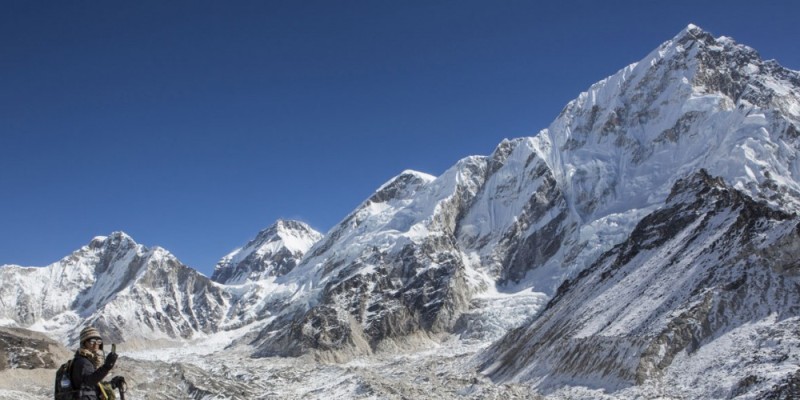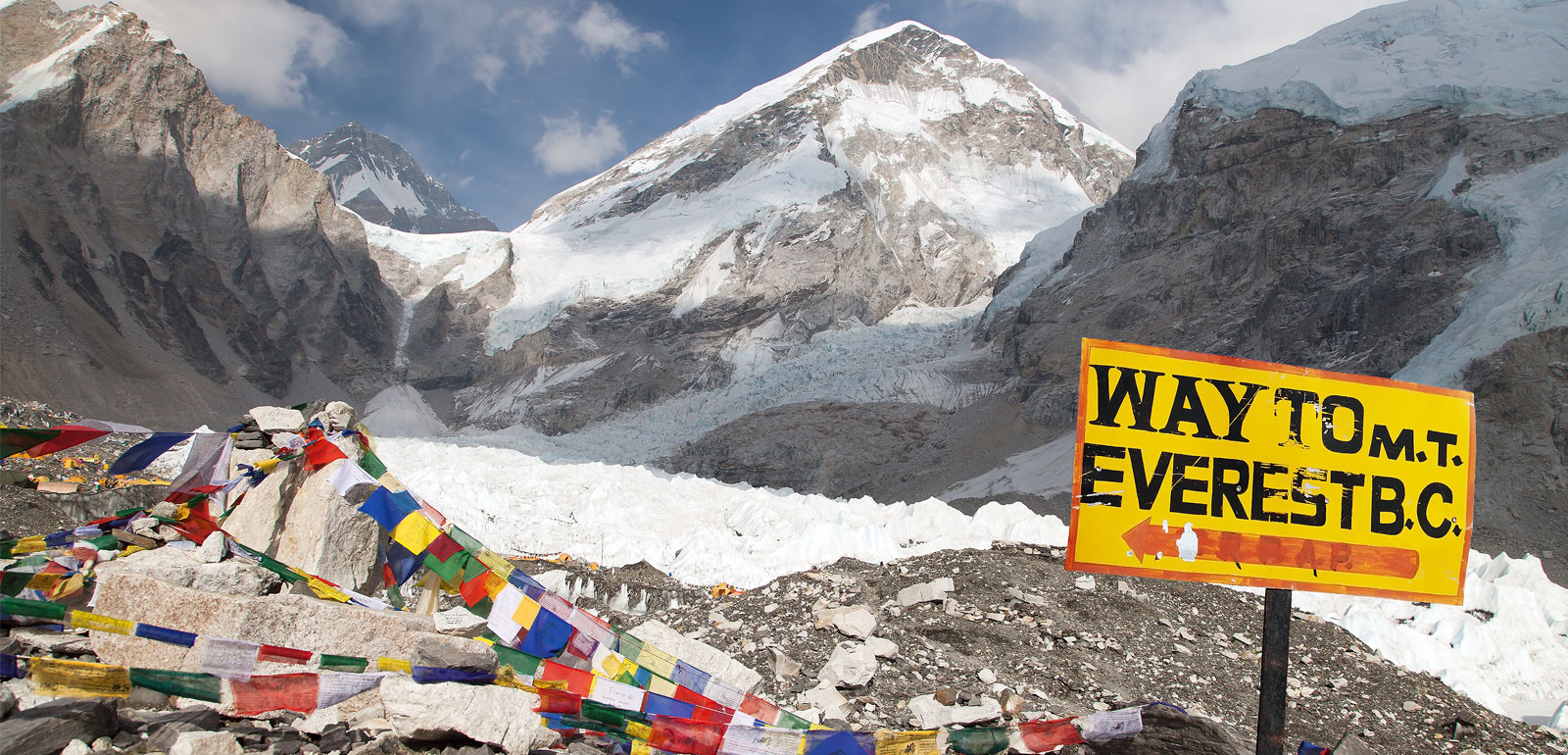

Everest Base Camp is the most popular trekking destination in the foothills of the highest mountain of the world, Mt. Everest (8848m). Everest Base Camp Trek is a thrilling and unforgettable lifetime experience. The journey takes you through the breathtaking high-altitude landscape, where you will pass through Sagarmatha National Park with its unique flora and fauna and glacial moraines all the way to EBC. During the trek, you can get the majestic views of the world’s highest peaks- Mt.Everest, Mt.Lhotse, Mt. Makalu, and Mt. Cho Oyu from the exclusive viewpoints. Not just the natural beauty, you can also explore highland Buddhist monasteries and the traditions, lifestyle & culture of the Sherpa people. The trip starts with a mind-blowing flight to Lukla and then passes through different Sherpa villages, monasteries, and glaciers with the mesmerizing background of the Himalayas till you reach the base of Mt. Everest.
Itinerary:
Day 01: Arrival Day in Kathmandu
Day 02: Fly to Lukla (2800m/9154ft) – 30 mins & Trek to Phakding (2650m/8692ft) – 3/4 hrs
Day 03: Trek from Phakding to Namche Bazaar (3440m/11283ft) – 5/6 hrs
Day 04: Acclimatization Day in Namche Bazaar
Day 05: Trek from Namche Bazaar to Tengboche (3870m/12694ft) – 5/6 hrs
Day 06: Trek from Tengboche to Dingboche (4410m/14465ft) – 5/6 hrs
Day 07: Acclimatization Day in Dingboche
Day 08: Trek from Dingboche to Lobuche (4928m/16164ft) – 6/7 hrs
Day 09: Trek from Lobuche to Gorakshep (5160m/16925ft), then to Everest Base Camp (5364m/17594ft) & Trek back to Gorakshep – 7/8 hrs
Day 10: Hike to Kalapathhar (5545m/18188ft) &Trek Down to Pheriche (4250m/13940ft) – 6/8 hrs
Day 11: Trek from Pheriche to Namche Bazaar (3440m/11283ft) – 5/7 hrs
Day 12: Trek from Namche to Lukla (2800m/9184ft) – 6/7 hrs
Day 13: Fly to Kathmandu– 30 mins
Day 14: Departure from Kathmandu
Best season to visit EBC
Time is one of the important things to be considered while trekking. Trekking in the best season gives you the best experience. To visit EBC, Spring (March-May) and Autumn (September-November) seasons are the best. During these seasons, the skies are clear and provide the most spectacular views. The trail is covered with flower blooms (during Spring) and perfect views of the Himalayas (during both seasons). It’s neither too hot nor too cold during these times and they give you the best views to enjoy your trek.
Guide and Porters
Trekking to high altitude landscape is hard. The trail will get narrow, confusing and challenging when you gain altitude. So, taking guide & porters is necessary while trekking in the mountain region. Guide and porters will guide you the way and help you with your luggage, accommodation, food & water. The guide will also provide necessary information about the safety measures and help you during emergency. Porters will help you to carry your luggage. With their help, you will have easy and hassle free travel.
Permits and Entry Fees
To trek in Nepal, you will need permits. In order to trek to Everest Base Camp, you need to have Khumbu Pasang Lhamu Rural Municipality Entrance Permit (Local Entry Fee) and Sagarmatha National Park Entry Permit. You can get the local entry fee at the trek entrance point in Lukla and National Park Permit at Nepal Tourism Board, Bhrikuti Mandap, Kathmandu or entry point at Monjo.
Sagarmatha National Park Permit fee for foreigners: Approx. US $30
Sagarmatha National Park Permit fee for SAARC nationals: Approx. US $ 15
Khumbu Pasang Lhamu Rural Municipality Entrance Permit: Approx. US $ 20
Food and water
Food and water are essential needs. While trekking, you need plenty of nutritious food. While trekking to EBC finding food and water is not difficult. On the way, you can find many tea houses and lodges where you will get fresh, hygienic, nutritious & tasty food. You will find local, western & Asian cuisine on the menu. Most of the time, the menu is basic.
Breakfast: Oatmeal, Corn Flakes, French Toast with Jam, Butter, Cheese, and Honey Tibetan Bread or Chapati, varieties of eggs (Omelettes) Pancakes, Muesli Breads, Fruits and Vegetables, Hot Drinks - varieties of Teas, Coffees, Hot Chocolates, etc.
Lunch/Dinner: Rice & Curry, Various Soup Items, Sherpa Stew, Sandwiches, Momo (Dumplings) Macaroni Dishes, Thenduk, Spaghetti Noodles, Thukpa, Pasta, vegetable Curry, Potatoes, Salad, Pizza etc.
While trekking you need to keep yourself hydrated with at least 4-5 liters of water per day. Lodges and tea houses on the trail will provide you with clean drinking water. Bring your bottle and refill it, to avoid plastic bottles. You can also carry water purification tablets.
Accommodation
Finding accommodation is not hard in EBC trek. You will find plenty of lodges and tea houses, where most of the rooms are twin-sharing. Getting attached bathroom rooms at high altitude is difficult. Though Everest region has find enough lodges and tea houses, sometimes it can be difficult to find rooms during peak season.
Communication
During the trek to EBC, you can use the internet service at the lodges and tea houses to communicate with your friends and family. You can also get NCELL & NTC network. But at high altitudes, communication can be unstable. You have to pay some extra charges for the service.
Electricity
Electricity is available at the lodges and teahouses where you will stay. You can charge your phones, laptops, and camera from the solar panels at lodges and teahouses but you have to pay some extra charges.
Difficulty level
EBC trek is a moderate grade adventure. The trails are narrow and steep, but well marked. In a day you need to walk for 6/7 hrs. At high altitude, you will have to walk through glaciers and you will also climb Kalapatthar (5545m) which will increase the difficulty level.
Clothing and gear/equipment
It is essential to carry good clothes and gear/equipment while trekking. Sometimes packing too less and too many cause a problem in your trek. So, make a list of the clothes and gear/equipment you want to take on the trek with you. Normally, it includes trekking bags, the upper body wears (T-shirts, thermal vests, lightweight thermal tops, waterproof jackets, fleece jackets or pullovers, women’s sports bras, and synthetic), the lower body wears (hiking shorts, fleece pants, waterproof shell pants, undergarments, lightweight walking pants), trekking shoes, thick socks, essential gears (sleeping bag, trekking pole, sunscreen, waters bottles, water purifiers, head torch, first aid kit, hand sanitizers, towel, wet wipes, toiletries), etc.
Trip Insurance
Travel insurance is really important. No matter how much you are prepared or take care of yourself, things are unpredictable in altitudes. So, it is necessary to have travel insurance that covers emergency heli evacuation.